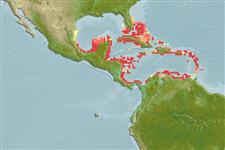Actinopterygii (ray-finned fishes) >
Pleuronectiformes (Flatfishes) >
Achiridae (American soles)
Etymology: Trinectes: Greek, tres, tria, = three + Greek, nekton = swimmer (Ref. 45335).
Environment / Climate / Range
Ecology
Marine; brackish; demersal. Tropical, preferred ?; - 9°N
Western Atlantic: southern Florida, USA and the Bahamas to Venezuela; absent from Gulf of Mexico.
Size / Weight / Age
Maturity: Lm ? range ? - ? cm
Max length : 15.0 cm TL male/unsexed; (Ref. 7251); common length : 10.0 cm TL male/unsexed; (Ref. 5217)
Inhabits clear waters of oceanic islands; also in bays and mangrove-lined lagoons along continental coasts, on sandy-muddy bottoms (Ref. 5217). Feeds on invertebrates. Sexually mature after two years. Females are bigger than males (Ref. 35237).
Life cycle and mating behavior
Maturity | Reproduction | Spawning | Eggs | Fecundity | Larvae
Robins, C.R. and G.C. Ray, 1986. A field guide to Atlantic coast fishes of North America. Houghton Mifflin Company, Boston, U.S.A. 354 p. (Ref. 7251)
IUCN Red List Status (Ref. 115185)
CITES (Ref. 94142)
Not Evaluated
Threat to humans
Harmless
Human uses
More information
Common namesSynonymsMetabolismPredatorsEcotoxicologyReproductionMaturitySpawningFecundityEggsEgg development
Age/Size
Growth
Length-weight
Length-length
Length-frequencies
Morphometrics
Morphology
Larvae
Larval dynamics
Recruitment
Abundance
ReferencesAquacultureAquaculture profileStrainsGeneticsAllele frequenciesHeritabilityDiseasesProcessingMass conversion
Tools
Special reports
Download XML
Internet sources
